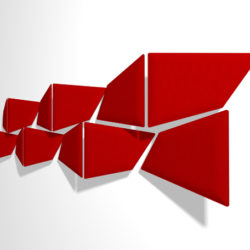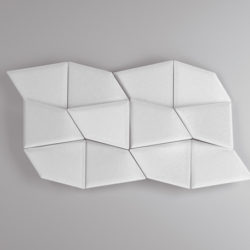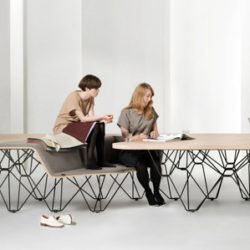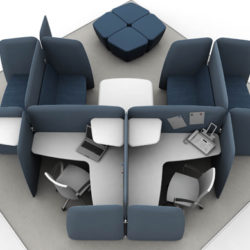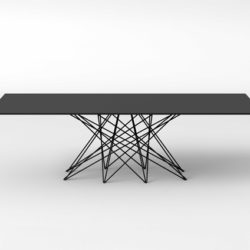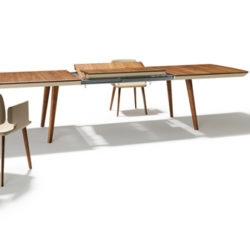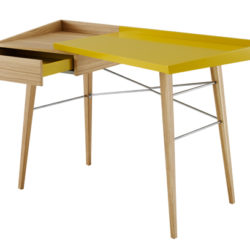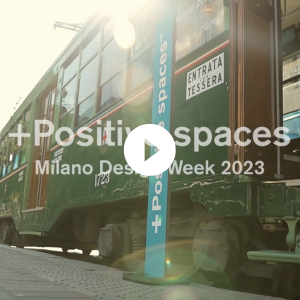WOW! leads you inside the amazing “Office for living” environments designed by the Pritzker Nouvel at Salone del Mobile 2013, Milan.
Nouvel’s eagerly-awaited staging didnt’ fell short of our expectations! Five glamorous settings, unconventional yet very concrete, since they are carried out with current products only, open onto the central “fire” burning the conventional office models. He, who thought to find ONE office model for the future was wrong.: Nouvel proposes some of the many models now possible, he suggests an idea of office based on the pursuit of pleasure and the new working ways, and how to find countless solutions of hybrid settings, home-work-leisure time, emotivity and technology. Places “soaked with generosity”, inspiring and welcoming us.
“Once we reject cloned and alienating spaces, it becomes clear that there are many possible solutions,” says Jean Nouvel. “We have to change our behaviours, plan and think of work with a different mindset: no matter where an office is situated, it has to have a space it can call its own, identifiable, alterable, on a human scale, with its own history and objects, an enjoyable environment, basically.”
Within a dedicated 1,200 m2 area inside SaloneUfficio’s pavilion 24, Jean Nouvel explores contemporary building concepts informed by a rejection of cloned, alienating, standardised and serially repetitive spaces, inspiring exhibitors and visitors with different ways of achieving alternative aggregation formulas.
The “office for living” exhibit takes the form of a small district, a small city – showcasing unique and unusual work scenarios that endeavour to demonstrate that, because of their individuality, workspaces need to be able to make for happy living as well as to provide inspiration. These are not utopias, or showrooms, or collections of a few exceptional pieces: these offices are representative of ordinary situations, often existing ones, and feature office furniture produced in the main by SaloneUfficio exhibitors. A monolith rises in the middle of SaloneUfficio, as intriguing as it is inviting, showing four video-portraits – of the stylist Agnès B, the photographer Elliot Erwitt, the artist Michelangelo Pistoletto and the writer and film director Alain Fleischer – each raising their concerns and expressing their points of view on the office space. Five groundbreaking work situations are freely grouped around the monolith, serving to accentuate just how outdated today’s attitudes to the workplace really are.
The first of these is a classic city-centre apartment, left intact: the reception rooms, bedroom, kitchen, fireplaces, floors and mouldings have been left untouched. The space, used for both work and entertaining, is furnished to chime with the original architecture and the echoes of the past, with several different activities taking place in a warm, intimate atmosphere. The spaces are comfortable, individual and original. The apartment serves as a pleasing backdrop for living, enabling self-expression through objects and work, conserving the functional ethos of the office yet without prompting the same resonance.
The second is informed by the increasing vogue for working from home. During the day the house serves as an office, reprising its domestic function in the evenings, at weekends and on days off. “Habitation” and “office” become interwoven: the lines between office and home furniture become blurred, in a space in which even the objects have a dual existence.
Then there is an open space, containing pieces of industrial furniture that can be put together, stacked, taken apart and reassembled, breaking with the totalitarian, repetitious character of today’s offices. Furniture from several different eras is combined, incorporating objects from different spheres. The openness of the space enables everyone to express themselves freely, building their own working environments: cut off from their neighbours or in close contact; sitting on their desks or hunkering down on them. Different varieties of wood, cardboard, leather and coloured plastic rub shoulders, crowned with atypical and unexpected objects, marking out an irregular and astonishing cityscape.
The fourth space consists of a warehouse, a basic steel container of the kind found in city suburbs the world over. These often-empty cubes make for free-range furnishing. Their particular spatial quality affords each and every form of appropriation and differentiation. They make for and absorb specific non-systematic, totally flexible furnishing, lighting and decorating solutions. The scope for unfettered conversion is what sets this free space apart.
Rationalism provides the theme for the final space: a high-tech, open-plan office system which, while conforming to normality and to rational standardisation, is geared to transformation. The footprint, which may seem static and repetitive, is in fact free-form: sliding, collapsible walls enable individual offices to be built, either opening out into the adjacent space or the corridor or providing isolation. The doors are sliding or folding, there are blinds for light regulation, with frosted glass for intimacy. Sophisticated wood and chrome finishings and high-tech components impart a luxurious feel. An overall yet generous layout, geared to enjoyment in life
A light laboratory promoting artistic and pictorial lighting for working environments, breaking with the monotony of traditional, homogeneous office lighting, is another feature. Prototype lamps, providing hitherto undreamt-of lighting solutions enabling each person to create their own lighting system, are on exhibit. Spaces unfettered by traditional rules, therefore, with the concept of enjoyment in work firmly first and foremost, allowing people to put their own spaces together as best suits them, with plays of light and reflections.
Jean Nouvel has also put together a small compendium of furnishings by his great heroes, a homage to extraordinary designs of the past that are still tremendously contemporary. The pieces are displayed in front of the photographs of the places for which they were conceived by their “creators,” the masters who make up the imaginary museum that fires his inspiration. The VIP lounge, where Ron Arad, Michele De Lucchi, Marc Newson and Philippe Starck have been interviewed in their own workplaces and expounded on their visions, rounds off the project.

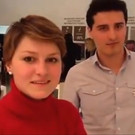

Photogallery captions:
1 Caimi Brevetti, Flap, design by Alberto Meda, Francesco Meda
Flap represents a major new milestone in acoustic panels (patented Snowsound® technology) and combines great formal simplicity with unique, advanced performance. Much more than just an acoustic panel, Flap improves the acoustic comfort in closed spaces while at the same time expressing formal and aesthetic strength, thanks to its ability to be assembled at will, creating a wide diversity of designs.
2 Prooff, SitTable, design by UNStudio, a thinking place as well as a social meeting ground. (Emporio, via Tortona 31).
3 Babini, Wall Street, wall consolle with executive desk Manatta.
4 Babini, Fly, product platform that allows different configurations (2 tops, 3 basements,3 cablign solutions, 4 screen typologies).
5 OfficeCity (Gruppo Quadrifoglio) Z2, a strong appeal reception system that uses a front combination of matt melamine and lacquered.
6 Frezza, Cruise, operative system, by Giacobone + Roj, Progetto CMR, avanguarde design and high level performances.
7 Las Mobili, Flags, operative system, Orlandini Design.
8 USM, Kitos E new desk (Salone Ufficio)and its evergreen furniturefor every work environments (Spotti, viale Piave).
9 Desalto, Sail, television holder system, design Caronni Bonanomi.
10 Clic iPad Pond, di Diffusion Design an example of smart design furniture integrating high-tech devices. (Danish LivingRoom Salone del Mobile hall 10).
11 Bonaldo, Octa, 8-legs table by Bartoli Design.
12 Team 7, table Faye, Interior Innovation Award 2013 (at Spazio RivaViva, via Porro Lambertenghi).
13 Ligne Roset, Litho, a poetic approach to workplace, design Thibault Desombre.

